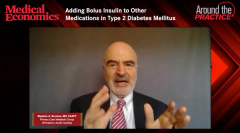
Benefits of Technology of Insulin Pumps
Episodes in this series

Dhiren Patel, PharmD, CDE, BC-ADM, BCACP: Diana, we talked about downloading reports. During this pandemic, if remote monitoring was ever going to be a big theme, it’s now. I don’t think it’s a trend; it’s here to stay. Talk to me about once a patient is on a pump. What are you doing with the software, the reports, and the remote monitoring? What does that look like once a patient is on it? They’ve understood the features that they want to utilize. How are you interacting with them, especially when it’s not in person?
Diana Isaacs, PharmD, BCPS, BCACP, BC-ADM, CDCES: We’re trying to optimize virtual care. Many times, we will bring patients in face-to-face for that initial training and then do the follow-up virtually. We have some patients who even opt to do that initial training virtually, so even that is sometimes done virtually on a case-by-case basis.
There are typically 2 ways to download data. One is directly downloading it, depending on the device, through either plugging it in or via Bluetooth. What is expanding and is exciting is the use of mobile apps with smartphones. Through Bluetooth connectivity, the data download seamlessly and go to a portal that we clinicians then go into. Our patients’ data are already there because they’re uploading every day through Bluetooth.
That is important, especially in the beginning when you’re trying to titrate. You’re trying to determine if you need to adjust the basal insulin doses, if the carbohydrate ratio is optimized, or if your meal settings are optimized if you’re using those. We have access to that data as well for data-driven discussions. When you have access to that data, you can ask more specific questions. My approach is like this: I like to focus on what it’s like on the best day. I say, “This day, you were in the range most of the day. What was working well? Let’s try to repeat that.” Then, of course, if you notice things like hypoglycemia, so you’re trying to address that. Being able to view that data virtually is amazing.
Dhiren Patel, PharmD, CDE, BC-ADM, BCACP: That’s helpful. Steve, you shared a pretty personal experience with your daughter being on an insulin pump. Bob, you talked earlier about getting hugs from your patients, so we’ll start with you. What does this do for your patients from a quality-of-life standpoint? I see the injection burden go down significantly where some patients will say, “I don’t know what to do. I have all this free time.” Talk to me about a personal experience or a patient story where you have that feel-good moment.
Robert Busch, MD: With the connected pumps with the automatic shutoff, patients who have had nocturnal hypoglycemia in the past were gun shy in trying to optimize their morning reading. Now with that extra security or extra Guardian technique that they have with the automatic shutoff, they can be more aggressive knowing that’s there. That’s a big deal because once someone gets severe hypoglycemia, they’re gun shy, and all the A1C [glycated hemoglobin] levels will be over 8% for quite a while afterward. Getting them back to control knowing they have that security blanket is important.
Stephen A. Brunton, MD, FAAFP: I like what Diana is talking about in terms of the sophistication and what the pump can do if you know how to do it. I find it empowering for patients because they can take control of their diabetes rather than let their diabetes control them. When you can, if you’re going to have pizza, especially with kids who want to have a pizza party, they can make the appropriate adjustment, so they’re not going to be high and then low. This gives the person a much greater understanding of what their diabetes is and what they can do to manage it. That is very exciting.
Robert Busch, MD: You’re restoring normal physiology to them. One of my partners, whom I call a pump princess, is like you are, Diana. She called it designer bolus insulin. You’re calling it the extended bolus insulin, but it’s a designer bolus insulin. She customized it for the patient. They love it. They’d come back to me saying, “I extend the bolus insulin when I have pizza, and I do this for other things.” It normalized their life again, which they haven’t had for a while with standard basal bolus insulin therapy. It is also for the patient who is on a basal insulin, but they’re bottoming out at certain times, or even giving a variety of basal insulin doses during the day rather than fixing it and using their basal insulin to tune up their morning. They could have a variety of basal insulins, and that is a big deal as well, aside from the designer bolus insulins.
Diana Isaacs, PharmD, BCPS, BCACP, BC-ADM, CDCES: I’m totally going to go by that now: pump princess. I love it. You made a good point about restoring the normal physiology. When we just use a long-acting insulin, we’re assuming that a person needs the exact same amount of background insulin at every hour, every minute of the day. That’s not true physiology. People need different amounts. In the afternoon, they may need a little less, and before waking up, they may need a bit more. With the pump, we can customize it. We can break it down to every hour, but we can customize those settings.
Dhiren Patel, PharmD, CDE, BC-ADM, BCACP: Diana, that would be a great Twitter handle: pump princess.
Stephen A. Brunton, MD, FAAFP: It’s an exciting time to be managing diabetes. For us to be able to talk about what we have, in terms of not just different therapies and the pathophysiology but also the different technology trying to add normalcy to a person’s life. It’s miraculous. When Bob and I were first managing diabetes, you had to look for the ants on the wall for the sugar in the urine, but compared with now, we’ve come a long way.
Diana Isaacs, PharmD, BCPS, BCACP, BC-ADM, CDCES: I totally agree. I tell anyone who has diabetes, “This is the best time in the world to get diabetes if you have to get diabetes.” With where technology is going too, with more integration with CGM [continuous glucose monitoring] and automated insulin dosing with hybrid closed loops, it’s very exciting. The advances are coming quickly.
Robert Busch, MD: None of us will ever retire, Stephen. We’ll be doing this forever.
Stephen A. Brunton, MD, FAAFP: Speak for yourself.
Robert Busch, MD: You can always do 1 better, especially with research studies and knowing what’s cooking down the line. Why would you want to retire when you have these great drugs coming out?
Stephen A. Brunton, MD, FAAFP: Bob, your patients have your home number, so you can never retire.
Robert Busch, MD: They’re starting to ask me that. Seriously. I tell them, “I’m going to retire when you’re 100. Please call me that day because that’s the day I’m retiring.”
Newsletter
Stay informed and empowered with Medical Economics enewsletter, delivering expert insights, financial strategies, practice management tips and technology trends — tailored for today’s physicians.











